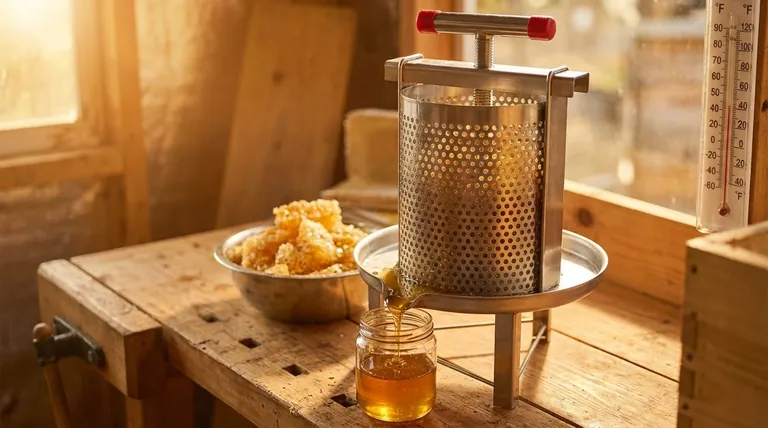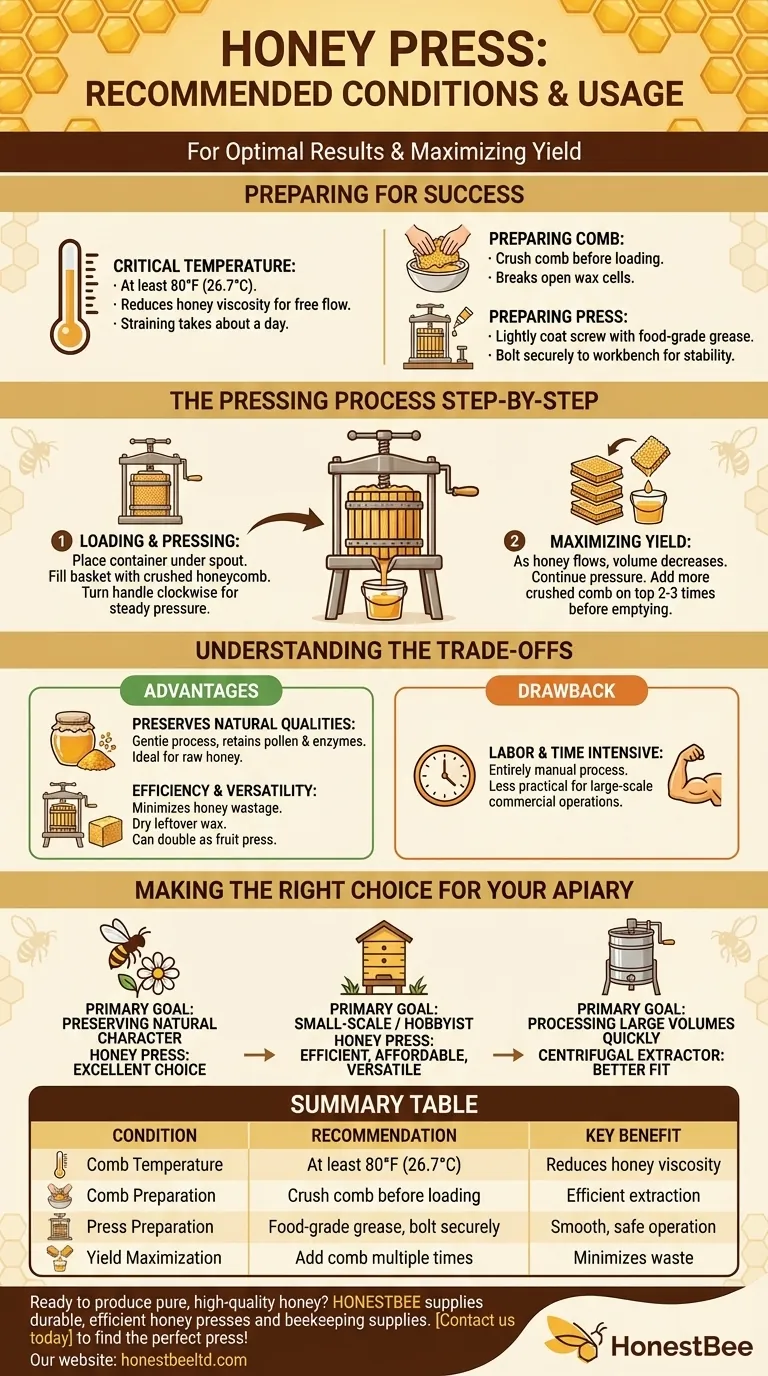For optimal results, a honey press should be used on comb that has been warmed to at least 80°F (26.7°C). This significantly reduces the viscosity of the honey, allowing it to flow freely from the wax. At this temperature, the entire straining process can typically be completed in about a day.
A honey press is a highly effective tool for small-scale beekeepers, but its success depends on two key factors: properly warming the honeycomb to ensure honey flows easily and following a methodical preparation and pressing process to maximize your yield.

Preparing for a Successful Press
Success with a honey press begins before you ever turn the handle. Proper preparation of the comb and the press itself is essential for an efficient extraction.
The Critical Role of Temperature
The single most important condition for pressing honey is warmth. Honey is viscous, and cold temperatures make it thick and incredibly difficult to separate from the comb.
Aim for a comb temperature of at least 80°F (26.7°C). If the ambient temperature is below 70°F (21.1°C), the process can slow dramatically, taking several days to complete.
Be careful not to overheat the comb, as excessive heat can degrade its natural enzymes and nutritional value.
Preparing the Comb
Do not place whole frames or large chunks of comb directly into the press.
You must crush the comb before loading it into the press basket. This breaks open the individual wax cells, creating pathways for the honey to escape under pressure.
Preparing the Press
Before each use, lightly coat the press screw and other moving parts with a food-grade grease or oil. This ensures smooth operation and prevents seizing.
For stability and safety, it is highly recommended to bolt the press securely to a sturdy table or workbench before you begin.
The Pressing Process Step-by-Step
Once preparation is complete, the pressing process is straightforward and methodical.
Loading and Pressing
Place a suitable collection container, such as a food-grade bucket, directly under the press spout.
Fill the press basket with your crushed honeycomb. Turn the handle clockwise to lower the pressing plate and apply steady, consistent pressure.
Maximizing Your Yield
As the honey flows out, the volume of wax in the basket will decrease. Continue turning the handle until the honey flow slows to a drip.
For maximum efficiency, add more crushed comb on top of the already pressed wax at least two or three times before emptying the basket. This allows the new honey to flow through the existing pressed comb, minimizing waste.
Understanding the Trade-offs
A honey press is an excellent tool, but it's important to understand its specific advantages and limitations compared to other methods like centrifugal extraction.
Key Advantage: Preserving Natural Qualities
The crush-and-strain method is a gentle process that preserves the natural characteristics of the honey. Many beekeepers prefer it for producing raw honey that may contain more pollen and fine wax particles.
It is also an ideal method for non-standard frames, such as those used in Warre hives, which do not fit in conventional extractors.
Key Advantage: Efficiency and Versatility
For its intended scale, a honey press is very efficient, minimizing honey wastage. The leftover pressed wax is very dry.
Its small size, reasonable price, and versatility also make it appealing. Many models can double as a fruit press for making juice or cider.
The Major Drawback: Labor and Time
The primary trade-off is that a honey press is labor-intensive and time-consuming. The process is entirely manual, from crushing the comb to turning the press handle.
This makes it perfectly suited for hobbyists but less practical for large-scale commercial operations that need to process high volumes quickly.
Making the Right Choice for Your Apiary
A honey press is a fantastic investment for the right beekeeper. Use your primary goal to determine if it fits your needs.
- If your primary focus is preserving the raw, natural character of your honey: A press is an excellent choice that avoids the high-speed processing of an extractor.
- If you are a small-scale or hobbyist beekeeper: The press offers an efficient, affordable, and versatile extraction method without a large footprint.
- If your primary focus is processing large volumes of honey quickly: The manual, labor-intensive nature of a press means a centrifugal extractor is likely a better fit for your operation.
Ultimately, using a honey press correctly allows you to produce pure, high-quality honey with minimal equipment and investment.
Summary Table:
| Condition | Recommendation | Key Benefit |
|---|---|---|
| Comb Temperature | At least 80°F (26.7°C) | Reduces honey viscosity for easier flow |
| Comb Preparation | Crush comb before loading | Breaks wax cells for efficient extraction |
| Press Preparation | Use food-grade grease; bolt for stability | Ensures smooth, safe operation |
| Yield Maximization | Add comb multiple times before emptying | Minimizes waste and increases efficiency |
Ready to produce pure, high-quality honey with the right equipment? HONESTBEE supplies durable, efficient honey presses and other beekeeping supplies perfect for hobbyists and small-scale apiaries focused on preserving the natural character of their honey. Contact us today to find the perfect press for your extraction needs and maximize your yield!
Visual Guide

Related Products
- Easy Use Manual Stainless Steel Honey Press for Honey Comb
- Stainless Steel Manual Honey Press with Guard for Pressing Honey and Wax
- Electric Honey Press Machine for Squeezing Honey Comb Press Equipment
- 10L Stainless Steel Electric Honey Press Machine
- Stainless Steel Honey Press Wax Press with Tank
People Also Ask
- How does a honey press benefit chunk honey production? Unlock Authentic, Artisanal Honey Quality
- What are the two most popular types of machines for honey extraction? Choose the Right Tool for Your Apiary
- What are the steps to operate a bucket honey press? Maximize Your Honey Yield with Simple Mechanical Force
- What are the key features of a honey press? Maximize Yield with Durable, Efficient Extraction
- What are the reasons for choosing a honey press over a dedicated honey extractor? Maximize Disease Control and Natural Beekeeping



















